“], “filter”: { “nextExceptions”: “img, blockquote, div”, “nextContainsExceptions”: “img, blockquote, a.btn, a.o-button”} }”>
Always tired? Experience trouble sleeping? Find it difficult to concentrate throughout your day? These are only some of the ways that unaddressed anxiety can come out sideways in everyday life.
Studies estimate that up to 30 percent of adults experience intense anxiety at some point during their lifetime. Even without (gestures at everything the last few years), it can be exasperatingly difficult to stay calm and grounded. But when those feelings linger unaddressed, they eventually intensify and interfere with your ability to function in routine ways in life, work, and relationships.
Although yoga isn’t the solution to anxiety, it can help.
See also: How Yoga Can Help Your Mental Health
How does yoga help with anxiety?
Research indicates that yoga helps mitigate anxiety by interrupting anxious thought patterns with mindful movement. This effectively halts the feedback loop of negative thoughts that create a continued heightened emotional state.
The self-awareness that happens with a regular yoga and meditation practice can help you develop the tools—including slowing your breath, becoming aware of tension, and quieting your thoughts, even remaining still through discomfort or uncertainty—that help you better cope with everyday stressors as well as panic attacks.
Physiologically, certain styles of yoga and and increased emphasis on your breath can slow your heart rate, lower your blood pressure, and kick you out of the fight, flight, or freeze response and into a more easeful nervous system response.
The following yoga postures can help ease the symptoms of anxiety long enough so you can come back to yourself. Ideally, it is used as complements to therapy and medication so that you can not only escape the symptoms but learn a different way to cope.
See also: Expert-Approved Tips to Calm Anxiety
9 yoga poses for anxiety
1. Sun Salutation A, variation
Why this series helps anxiety: The rhythm of this sequence calms your brain and helps you breathe more deeply.
How to: From a standing or seated position (in a chair works great!), inhale and sweep your arms out to your sides and overhead. As you exhale, turn your palms down and hinge at the hips to fold forward. Place your palms on your thighs and on your inhale press back up. As you rise, lift your arms back out to the sides and overhead. Repeat 6–10 times. On the final fold, release your hands toward the floor and let your head hang between your legs for 30 seconds. Come back up halfway and take a couple of breaths before pressing your palms into your thighs and rising all the way back up.

2. Balasana (Child’s Pose)
Why this pose helps anxiety: The forward bend and the proximity to the ground help calm your entire system.
How to: Kneel on the floor. Touch your big toes together and sit on your heels, then separate your knees about as wide as your hips. Exhale and lay your torso down between your thighs.
Broaden your sacrum across the back of your pelvis and narrow your hip points toward the navel, so that they nestle down onto the inner thighs. Lengthen your tailbone away from the back of the pelvis while you lift the base of your skull away from the back of your neck. Rest your forehead on the mat.
Stretch your arms forward with your palms down and fingers spread wide. Breathe deeply and stay here for a few minutes.

3. Uttanasana (Standing Forward Bend)
Why this pose helps anxiety: Standing Forward Bend relieves stress and takes advantage of gravity to help relax your shoulder and neck, which is where we often hold a lot of tension.
How to: Stand straight up in Tadasana, hands on your hips. Exhale and bend forward at your hips, not your waist, to lengthen the front torso.
If possible, with your knees straight, bring your palms or fingertips to the floor slightly in front of or beside your feet, or bring your palms to the backs of your ankles. If this isn’t possible, cross your forearms and hold your elbows. Press the heels firmly into the floor and lift the sitting bones toward the ceiling. Turn the top thighs slightly inward.
With each inhale, lift your body slightly. With each exhale, release into the pose a little more. Let your head hang from the root of the neck, which is deep in the upper back, between the shoulder blades.
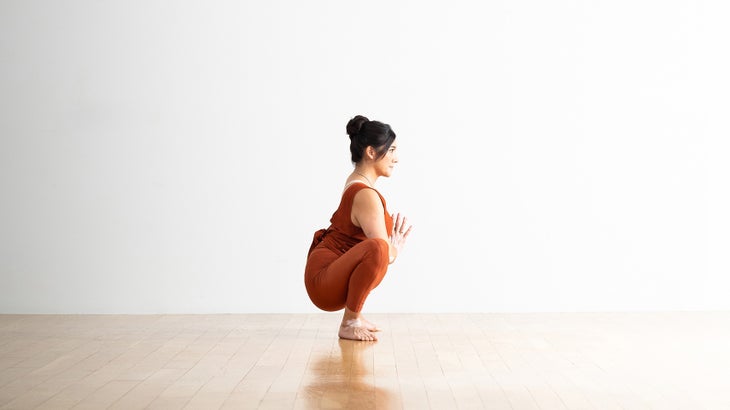
4. Malasana (Garland Pose)
Why this pose helps anxiety: Garland Pose draws your energy down, which can be very grounding when you feel scattered, stressed, or anxious (or all three).
How to: Squat with your feet as close together as possible. Keep your heels grounded on the floor if you can. If not, roll up your mat or put a towel under them. Separate your thighs slightly wider than your torso. Exhaling, lean your torso forward and fit it snugly between your thighs.
Press your elbows against your inner knees, bringing your palms together in Anjali Mudra (Salutation Seal), and resist the knees into the elbows to help lengthen your front torso. Hold for 30–60 seconds.
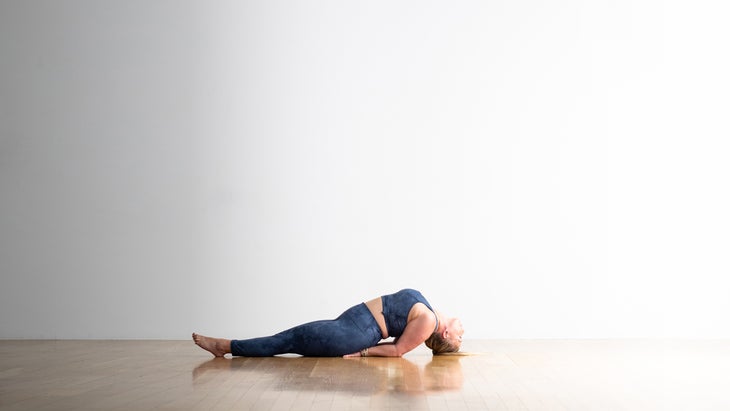
5. Matsyasana (Fish Pose)
Why this pose helps anxiety: Backbends open up the front of your body, releasing stress that you might be holding in your chest and/or shoulders. This supported variation makes the pose more comfortable to hold and relax into.
How to: Rest your head on a block at its highest position and place a block under the middle of your back at its middle height. Bend the knees and place the soles of your feet on the floor. Relax your arms and let them sit naturally at your sides, palms up. Breathe in this position for 1–3 minutes or longer.
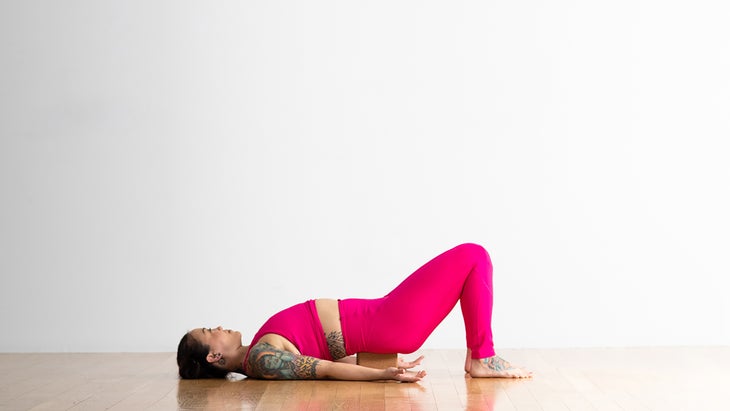
6. Setu Bandha Sarvangasana (Bridge Pose)
Why this pose helps anxiety: If Fish Pose feels too intense, try Bridge Pose for a moderate backbend.
How to: Lie supine on the floor, and if necessary, place a thickly folded blanket under your shoulders to protect your neck. Bend your knees and set your feet on the floor, heels as close to the sitting bones as possible. Exhale and, pressing your inner feet and arms actively into the floor, lift the buttocks off the floor. Keep your thighs and inner feet parallel. Clasp the hands below your pelvis and extend through the arms to help you stay on the tops of your shoulders. Lift your chin slightly away from your sternum and press the top of your sternum toward the chin.
Add a block at any height under your sacrum/lower back for a supported version of this pose. Stay here for 30 seconds to 1 minute. Release with an exhalation, rolling your spine slowly down onto the floor. Lift and remove the block before rolling down to the floor.
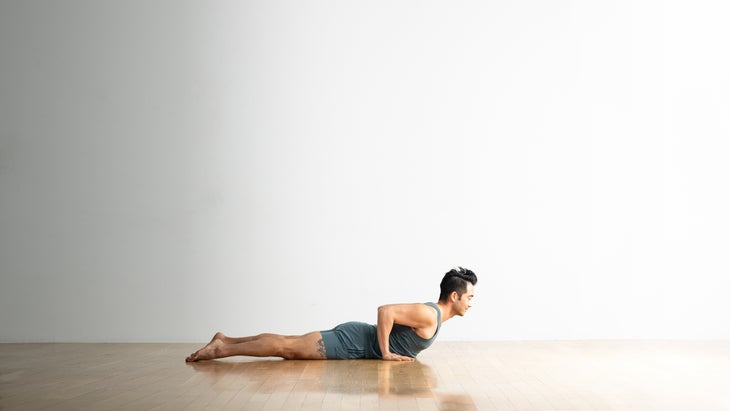
7. Cobra Pose (Bhujangasana)
Why this pose helps anxiety: Cobra Pose is another backbend option that offers more chest opening. Always move into this pose slowly to avoid straining your back.
How to: From Sphinx Pose, firm your shoulder blades against your back and begin to press into your arms to lift your chest. Avoid pushing the ribs forward and distribute the backbend evenly throughout your spine. Hold for 15–30 seconds and then release back down to the floor on your exhale.
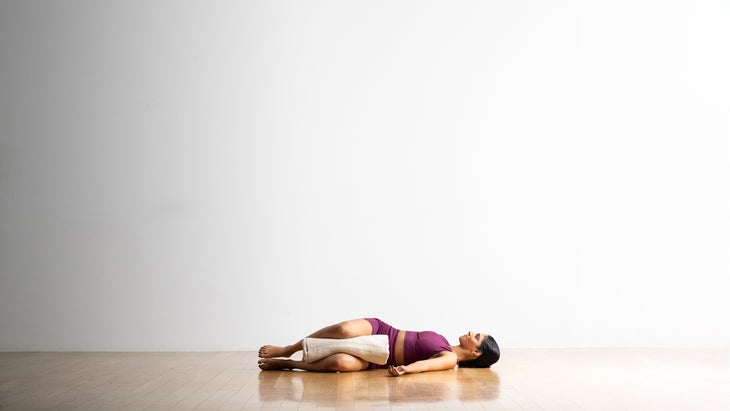
8. Supta Matsyendrasana (Supine Spinal Twist)
Why this pose helps anxiety: Supine Spinal Twist lengthens and relaxes your spine, which is great for relieving tension while also giving you energy.
How to: Lie fully extended on your back and make a T with your arms out to the sides at shoulder level. Bend your knees and inhale as you lift your feet off the floor, bringing your knees directly over your hips to create a right angle with your legs. Exhale and let your knees fall to your right. Keep your shoulders on the mat. Your left hip will lift as you twist to the right. Hold for 1-2 minutes. Bring your legs back to center and switch sides.

9. Vrksasana (Tree Pose)
Why this pose helps anxiety: Tree Pose helps you feel more grounded, centered, and steady.
How to: Start in Tadasana (Mountain Pose). Find your drishti a few feet in front of you. Inhale, bending your right knee and placing the sole of your right foot along the inside of your left leg. If you are unsure of your balance, start with your right foot next to your left ankle, moving up until you find the inside of your left thigh. Anywhere works, really, except your knee joint—do not put your right foot on the inside of your left knee.
Keep your hips squared toward the front of your mat as you press your right foot and your left inner thigh together. Your arms can stay at your sides, go above your head, or come together at your heart. Hold for 5–10 breaths and then exhale back to Tadasana.
See also: What Yoga Philosophy Helped Me Understand About Anxiety

